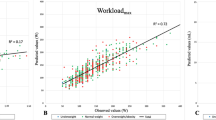Abstract
Background
Spiroergometry has been established to determine physical capacity. Reference values collected mostly in a younger population can be obtained from a number of studies and therefore may differ. Regression equations are complex and cannot be transferred easily to clinical practice. Our aim was to obtain reference values for spiroergometric parameters in cardiopulmonary exercise in healthy adult populations.
Methods
Eighteen studies of healthy adults (>40 years) that assessed maximal oxygen uptake (VO2max), oxygen uptake in relation to body weight (VO2max/kg), and oxygen pulse (VO2max/heart rate) were included. After data processing, spiroergometric parameters were correlated to age. Regression analysis was performed separately for each study and also weighted with the number of participants.
Results
For all spiroergometric parameters, age dependency was detectable for both males and females. After performing regression analysis, the following linear regression equations were determined: VO2max: Males = −28 × age (years) + 4,000; females = −20 × age (years) + 2,700 (ml/min); VO2max/kg: Males = −0.42 × age (years) + 58; females = −0.35 × age (years) + 46 (ml/min/kg); VO2max/heart rate: Males = −0.10 × age (years) + 20.50; females = −0.05 × age (years) + 13 (ml/min/heart rate).
Conclusions
The present study provides practicable reference values for the spiroergometric parameters of adult men and women.






Similar content being viewed by others
References
Preisser AM, Ochmann U (2011) Cardiopulmonary exercise testing in occupational medical fitness examination and assessment. Pneumologie 65:662–670
Posner JD, Gorman KM, Klein HS, Cline CJ (1987) Ventilatory threshold: measurement and variation with age. J Appl Physiol 63:1519–1525
Takeshima N, Kobayashi F, Watanabe T, Tanaka K, Tomita M, Pollock ML (1996) Cardiorespiratory responses to cycling exercise in trained and untrained elderly: with special reference to the lactate threshold. Appl Human Sci 15:267–273
Neder JA, Nery LE, Castelo A, Andreoni S, Lerario MC, Sachs A et al (1999) Prediction of metabolic and cardiopulmonary responses to maximum cycle ergometry: a randomised study. Eur Respir J 14:1304–1313
Koch B, Schäper C, Ittermann T, Spielhagen T, Dörr M, Völzke H et al (2009) Reference values for cardiopulmonary exercise testing in healthy volunteers: the SHIP study. Eur Respir J 33:389–397
Jones NL, Makrides L, Hitchcock C, Chypchar T, McCartney N (1985) Normal standards for an incremental progressive cycle ergometer test. Am Rev Respir Dis 131:700–708
Pothoff G, Winter U, Wassermann K, Jäkel D, Steinbach M (1994) Ergospirometric studies of normal probands for an unsteady-state increment test program. Z Kardiol 83:116–123
Saltin B, Grimby G (1968) Physiological analysis of middle-aged and old former athletes: comparison with still active athletes of the same ages. Circulation 38:1104–1115
Ong KC, Loo CM, Ong YY, Chan SP, Earnest A, Saw SM (2002) Predictive values for cardiopulmonary exercise testing in sedentary Chinese adults. Respirology 7:225–231
Åstrand I, Astrand PO, Hallbäck I, Kilbom A (1973) Reduction in maximal oxygen uptake with age. J Appl Physiol 35:649–654
Sidney KH, Shephard RJ (1977) Maximum and submaximum exercise tests in men and women in the seventh, eighth and ninth decades of life. J Appl Physiol 43:280–287
Blackie SP, Fairbarn MS, McElvaney GN, Morrison NJ, Wilcox PG, Pardy RL (1989) Prediction of maximal oxygen uptake and power during cycle ergometry in subjects older than 55 years of age. Am Rev Respir Dis 139:1424–1429
Fairbarn MS, Blackie SP, McElvaney NG, Wiggs BR, Paré PD, Pardy RL (1994) Prediction of heart rate and oxygen uptake during incremental and maximal exercise in healthy adults. Chest 105:1365–1369
Funk M, Schneider J (2012) Spiroergometric reference values for the sociomedical assessment of performance in adults aged over 60 years. Pneumologie 66:329–337
Neder JA, Nery LE, Peres C, Whipp BJ (2001) Reference values for dynamic responses to incremental cycle ergometry in males and females aged 20 to 80. Am Respir Crit Care Med 164:1481–1486
McDonough JR, Kusumi F, Bruce RA (1970) Variations in maximal oxygen intake with physical activity in middle-aged men. Circulation 41:743–752
Drinkwater BL, Horvath SM, Wells CL (1975) Aerobic power of females, ages 10 to 68. J Gerontol 30:385–394
Herdy AH, Uhlendorf D (2011) Reference values for cardiopulmonary exercise testing for sedentary and active men and women. Arq Bras Cardiol 96:54–59
Bruce RA, Kusumi F, Hosmer D (1973) Maximal oxygen intake and nomographic assessment of functional aerobic impairment in cardiovascular disease. Am Heart J 85:546–562
Vogel JA, Patton JF, Mello RP, Daniels WL (1986) An analysis of aerobic capacity in a large United States population. J Appl Physiol 60:494–500
Inbar O, Oren A, Scheinowitz M, Rotstein A, Dlin R, Casaburi R (1994) Normal cardiopulmonary responses during incremental exercise in 20- to 70-yr old men. Med Sci Sports Exerc 26:538–546
Hansen JE, Sue DY, Wassermann K (1984) Predicted values for clinical exercise testing. Am Rev Respir Dis 129(Suppl):49–55
Storer TW, Davis JA, Caiozzo VJ (1990) Accurate prediction of VO2max in cycle ergometry. Med Sci Sports Exerc 22:704–712
Lubinski W, Golczewski T (2010) Physiologically interpretable prediction equations for spirometric indexes. J Appl Physiol 108:1440–1446
Mohrer D, Liberati A, Tetzlaff J, Altman DG, for the PRISMA group (2009) Preferred reporting items for systematic review and mate-analyses: The PRISMA statement. PLoS Med 6:e1000097. doi:10.1371/journal.pmed.1000097
Conflict of interest
The author has no conflicts of interest to disclose.
Author information
Authors and Affiliations
Corresponding author
Rights and permissions
About this article
Cite this article
Schneider, J. Age Dependency of Oxygen Uptake and Related Parameters in Exercise Testing: An Expert Opinion on Reference Values Suitable for Adults. Lung 191, 449–458 (2013). https://doi.org/10.1007/s00408-013-9483-3
Received:
Accepted:
Published:
Issue Date:
DOI: https://doi.org/10.1007/s00408-013-9483-3




